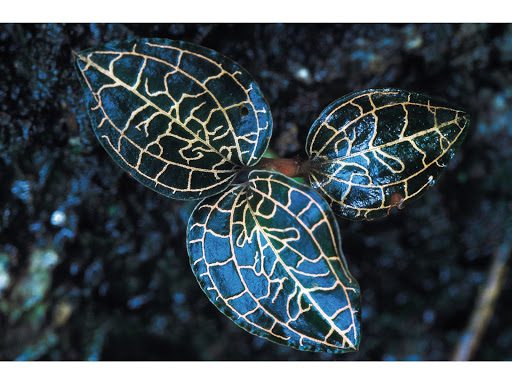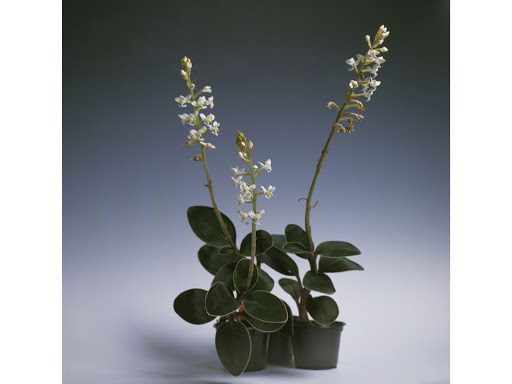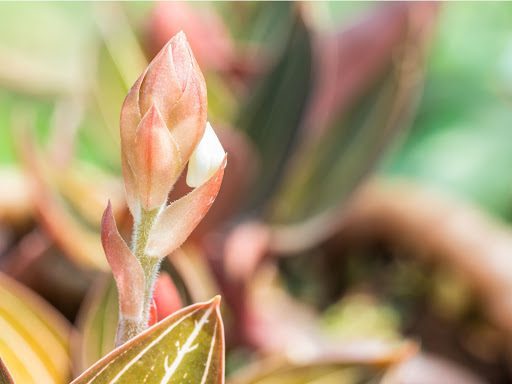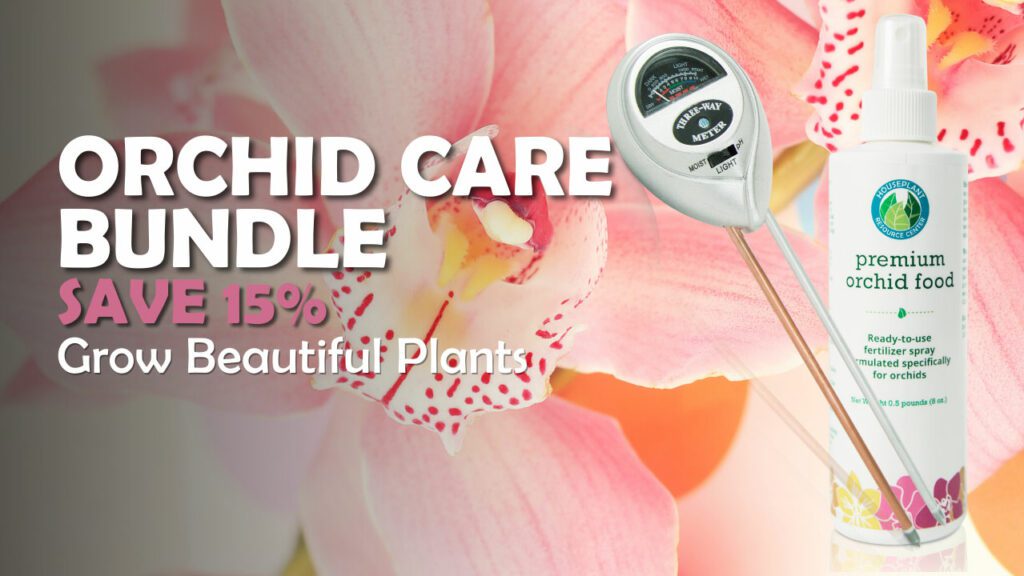When it comes time to choose an orchid, your options are endless. There are hundreds of stunning varieties of orchid plants, and most are known for their intricate and ornate blooms and bold, stunning colors.
But not all orchids are revered for their flowers.
The Jewel Orchid is a unique plant not necessarily known for its blooms, but for its foliage. Though, to be fair, the Jewel Orchid boasts its own beautiful flowers during bloom season.
Unlike other orchids, the Jewel Orchid offers year-round beauty, should be planted in traditional soil and is easily propagated.
Let’s take a deeper look at the unique features, needs, and care practices of the Jewel Orchid to set you up for growing success.

Where Are Jewel Orchids Found in the Wild?
Jewel Orchids are native to tropical environments, though they are increasingly rare in the wild. Most often, they’re found in the jungle forests in Indochina and the Pacific Islands.
Unlike other orchids, Jewel Orchids are terrestrial plants, which means they grow from the ground. Traditional epiphytic orchids, on the other hand, require no soil to grow and instead prefer to cling to trees. They are sometimes found many feet above ground since their unique root systems absorb nutrients from the air.
Typically, Jewel Orchids grow along running streams, in the crevices of boulders, and under the lush canopy of tropical rainforests.
Professional Tip: Before you purchase a Jewel Orchid for your indoor garden, don’t forget to take the plant’s natural habitat into consideration. If you can recreate the plant’s native environment (or even come close) you’ll have much luck growing the plant. If, on the other hand, your home environment won’t accommodate such conditions, it’s best to choose another addition to your garden.
What Are the Features of the Jewel Orchid?
There are two types of Jewel Orchids that are commonly sold for indoor use.
The first is called the Black Jewel Orchid, which sports deep-green leaves that appear almost black. The plant often boasts white stripes on its leaves, which sharply contrast the dark-green leaf color. Interestingly, each leaf’s underside is maroon, which gives the plant a stunning red hue in the right light conditions.
The second most popular Jewel Orchid is called Ludisia Discolor Alba. It’s rarer than the Black Jewel Orchid, though just as unique. Its medium-green leaves are piped with intricate white, silver, or yellow veins, which create detailed and perfectly symmetrical patterns on each leaf.
The Jewel Orchid flowers annually. The flowers last about a month or so before dropping.
Professional Tip: Jewel Orchids are great plants for growers with a tight budget. Most sellers will discount the plant after bloom season since most buyers are drawn to showy flowers. For lower price points, try purchasing a Jewel Orchid on off-seasons.
How to Position Your Jewel Orchid
In the wild, Jewel Orchids are often found in shady spots. Thick canopies allow dappled light to reach the plants, but they’re almost never found in harsh, direct sunlight.
For this reason, it’s best to position your Jewel Orchid in a north-facing window where it’ll get indirect sunlight.
If you’d prefer to keep your orchid in a south-facing position, be sure to shield your plant from harsh sun rays with a sheer curtain. And keep in mind that the easiest way to accidentally kill your Jewel Orchid is to position it in too much direct sunlight.

Professional Tip: While Jewel Orchids do like shady, low-light conditions, they will not do well in a dark room. Without adequate indirect light, your orchid will not grow and will quickly wilt and die.
The Best Potting Mix for Jewel Orchids
Because Jewel Orchids are terrestrial plants, they thrive in traditional soil mixes. For best results, use an organic potting mix that provides good drainage. If the soil retains too much moisture, your plant’s roots may suffer from root rot.
Professional Tip: Avoid using the same orchid potting mixes that you use for your epiphytic orchids since they contain far too much loose material and won’t provide adequate moisture for your Jewel Orchid.
Watering Your Jewel Orchid
The key to keeping your Jewel Orchid happy is to give it the right amount of water. Jewel Orchids thrive in slightly damp conditions, though they don’t do well in consistently wet soil.
Professional Tip: For best results, wait until the top inch of your potting soil is dry before giving your Jewel Orchid a good drink.
The Best Temperature and Humidity Levels for Your Jewel Orchid
Since Jewel Orchids are naturally found in tropical environments, they are not tolerant of frost. Warm, humid climates will lead to the best results.
If you have an indoor plant, avoid keeping it at temperatures below 50 degrees Fahrenheit. If you’re a bit chilly in your home, then chances are your Jewel Orchid is chilly too.
Professional Tip: Many home environments are too dry for Jewel Orchids to thrive. To give your plant the moisture it needs, place it on a humidity tray. This will help your plant bask in moisture-rich air, just like in the jungle.
Repotting Your Jewel Orchid
If your Jewel Orchid starts to become top-heavy, it’s probably time to repot it. As a rule of thumb, you’ll likely want to repot your orchid once every year or so.
When potting or repotting your Jewel Orchid, choose a pot that provides plenty of drainage and aeration. Ludisia plants tend to spread out rather than grow tall, so don’t worry about pot depth as much as pot circumference. Wide-mouthed pots are best for Jewel Orchids since they provide room for the plant to grow.
Professional Tip: For help choosing the perfect pot for your orchid, check out our article “The Ultimate Guide to Buying the Right Orchid Pot.“

When Will My Jewel Orchid Flower?
During autumn, fall, and winter months, your Jewel Orchid will sprout flower spikes. The spikes will bud and bloom during springtime. Some growers trim the flower spikes back to keep the foliage the focus of the plant. This also encourages your plant to grow more leaves, whereas allowing it to flower may lead to a leggy look.
The Jewel Orchid’s flowers are dainty, small, and numerous. Each bloom is white with a small yellow center. Blooms will last about a month before dropping.
Professional Tip: Good light conditions are directly tied to bloom health, so be sure to place your orchid in a well-lit spot where it gets plenty of indirect light.
Propagating Your Jewel Orchid
It’s easiest to propagate your Jewel Orchid through stem cuttings when you are repotting the plant. Stems are fairly brittle, so be gentle while transferring the plant and cutting its stems to make a new plant.
For best results, have a pair of sharp shears, a new pot, and a bit of soil ready. When you’ve clipped the stem, simply place it in the new pot and pack the soil into place to keep the plant steady. Since your clipping won’t grow full roots for a month or two, it can easily be knocked out of place.
Professional Tip: Try propagating your Jewel Orchid during spring and summer months, when growth is rapid. Winter months are often a time of slow growth, so it may take extra time for your new plant to sprout roots.
Set Yourself Up for Growing Success With Orchid Fertilizer
The best way to care for your Jewel Orchid is to use a reliable orchid fertilizer to nourish your plant. The right orchid fertilizer will support all of your efforts to keep your plant happy and healthy.
It’s important to note that specialized orchid fertilizers are different from traditional plant fertilizers. Their formulas are designed specifically for the unique needs of your orchid plant. The right orchid food will encourage healthy root growth, lush foliage, and reliable blooms.
The right orchid fertilizer will be specifically formulated for your plant’s unique needs and gentle enough so that you won’t risk damaging your orchid.
For best results, use our Premium Orchid Food to nourish your orchid with an easy-to-use spray formula. Simply spray the orchid food on your Jewel Orchid’s leaves, roots, and potting mix every time you water. Then sit back and enjoy those lush green leaves.



